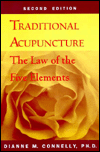In Traditional Chinese Medicine the body is regarded as a microcosm of the universe. Just as there are daily and seasonal cycles in nature, there are cycles of change in the body.
The Five Elements refer to a process of transformation from one state or phase into another. The five basic phases are named after categories found in Nature: Wood, Fire, Earth, Metal, and Water. Don’t be misled by the word “element,” which suggests something fixed and unchanging. The Five Elements or Five Phases are constantly interacting with each other to bring about change.
At any given moment, the proportion of these Five Elements determines our physical and mental states. When one element grows out of proportion, we experience mental disharmonies, such as anger, grief, fear, or worry, and physical complaints in the different organ systems, such as pain along the side of the body (the Gall Bladder meridian). Associated with each element is an extensive set of correspondences. For example, Wood is associated with anger, the Liver meridian, spring, the color green, and the eyes. Water is associated with fear, the Kidney meridian, winter, the color black, and the ears.
Five Element theory is a complex set of observations, correspondences, and relationships. Identifying and treating an Element that is out of balance can restore harmony to the body, mind, and spirit.
Both Between Heaven and Earth and Staying Healthy with the Seasons provide a simple introduction to Five Element theory. Between Heaven and Earth has a lengthy questionnaire to help you identify your type (Wood, Fire, Earth, Metal, or Water). Identifying your type can be very helpful as part of the process of coming into balance.
Note that the links below will open in a second browser window.
|
Traditional Acupuncture: The Law of the Five Elements
by Dianne M. Connelly
The information in this book is very basic, but it serves as an excellent introduction to the subject. It captures the essence of Five Element theory, which is that Chinese medicine, at its best, seeks to identify the source of imbalance, not simply to treat symptoms. The author was a student of J. M. Worsley, who brought Five Element theory to the attention of Westerners in the last century.
[back to top]
|
|

|
| |
|
|
|

|
|
In the Footsteps of the Yellow Emperor: Tracing the History of Traditional Acupuncture
by Peter Eckman
Peter Eckman is an MD and acupuncturist who studied with J.M. Worsley in England. Worsley can be credited with bringing Five Element Acupuncture to the West. Exactly where Worsley learned his methods is a mystery that Eckman has spent 20 years investigating. (Worsley, for reasons known only to him, did not wish to reveal his sources. He died in June 2003.)
As a former professor of the History of Science and Medicine, I found this book fascinating. Eckman traces the history of Chinese medicine back to its origins, then follows it through numerous dynasties, up to the dramatic changes of the twentieth century. One comes away with an appreciation for the great variety of theories and techniques that continue to inform the practice of Chinese medicine. There are fascinating stories about the tendencies to rivalry and hubris that are unfortunately so much a part of human nature. The book has multiple photos and illustrations on almost every page, which brings the material to life.
[back to top]
|
| |
|
|
|
|
|
What Is Five Element Acupressure?
An article on this website on Five Element Acupressure. Includes my own artistic rendering of the Creative and Controlling cycles. “A Five Elements practitioner attempts to identify which Elements are imbalanced and to locate blocks in the natural flow of nourishment from one Element into the next.”
[back to top]
|
| |
|
|
|

|
|
Zen Dynamics
This site includes a self-assessment test that analyzes your personality in terms of the Five Elements.
[back to top]
|
| |
|
|
|

|
|
Five Element.com
One of the few websites exclusively devoted to this subject. I don’t feel it does a great job of conveying the true value of Five Element theory, but it does serve as a resource. There are a few PDFs and some other resources listed at the bottom.
[back to top]
|
| |
|
|
|
Many websites on Chinese Medicine include a brief discussion of Five Element Theory. They usually contain a short table of correspondences for the Five Elements, plus illustrations of the nourishing and controlling cycles. Here are a few selections:
[back to top]
|
| |
|






















